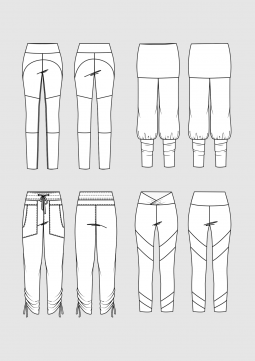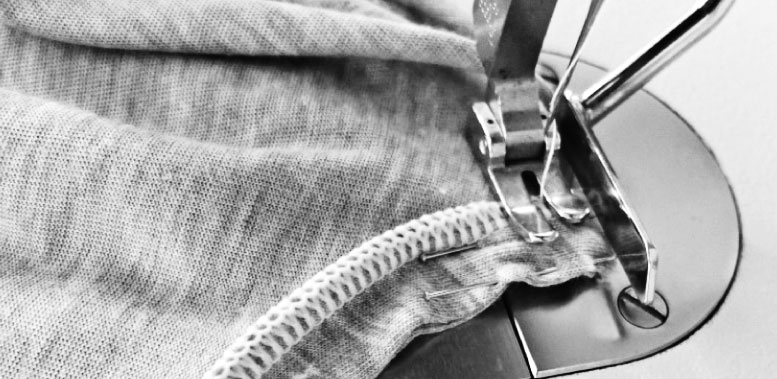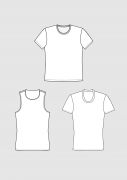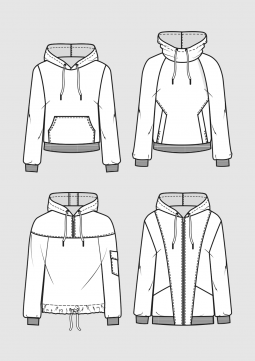Sewing Jersey Fabrics
Deutsch
Material damage and missing stitches when sewing jersey and other elastic fabrics
The fashion industry is subject to constant change. There are always new fabrics, and every fabric behaves differently. Knitted fabrics like single jersey, double jersey, stretch and other elastic fabrics with elastomeric threads are particularly sensitive. The most common sewing problems encountered when sewing are material damage with pricked knit threads and missed stitches with irregular seams. Often the cause of sewing problems is that the wrong needle has been inserted in the sewing machine. In the following article you will find helpful tips on how to sew Jersey and Co. correctly.
Which needle gauge is optimal for sewing jersey also depends on the sewing thread used. The success of the perfect seam always depends on the interaction of the sewing machine needle, the thread, the sewing machine and of course the skill of the person sewing. But in the end it is the material that determines the gauge of the needle to achieve a damage-free piercing. In principle, the finer the stitch structure of the fabric, the finer the needle should be. In other words: the smaller the diameter of the sewing needle, the less the stitch threads are displaced or widened when sewing. If you have chosen the smallest possible needle gauge, no damage is to be expected if the stitch threads have sufficient elasticity. If the elasticity limit of the threads is exceeded by a needle that is too thick and the friction at the binding points of the stitches is too great, the fabric is damaged during sewing; the material threads are “blasted”.
What needle for jersey fabric?
For processing jersey and all kinds of stretchy materials, needles with rounded tips, so-called ball points, are recommended. Due to their rounded tips, jersey needles displace the threads in the fabric particularly well. Which ball point to use in each individual case depends mainly on the characteristics of the material to be sewn. Fine knitwear, from which blouses or lingerie, for example, are made, should generally be processed with relatively thin needles (NM 60 to NM 70). The SES point (small ball point) is recommended before all others. The field of usage of medium to coarse knitwear is large and ranges from sportswear to corsetry. For these material thicknesses the recommended needle gauge is between NM 75 and NM 90, depending on how many layers of material and/or interlinings are processed. The needles should have a SUK point (middle ball point) which is rounded off a little more than the small ball point SES.
Special demands on the needle are made by very coarse knitwear and elastic materials with braided elastomeric threads, from which sportswear, for example, is made. Here, the SKF point, the large ball point, should be used. Thanks to its particularly strongly rounded point shape, this needle point ensures a punctual displacement of coarse, wide stitches without piercing the material threads. A material that has been used for a long time due to its good wearing properties is Lycra. With finer Lycra material, the best results are achieved with the SKF point (large ball point) in very fine needle thickness (NM 65 to NM 70). Medium to coarse Lycraware, e.g. for underwear and swimwear, is best processed with the SKL-tip (special ball point), also in very fine needle gauge. The special shape of this point ensures the optimum displacement of the material; the needle penetrates into the gaps in the material and past the elastomer threads without damaging them.
- Fine knitwear ( for example for fine shirts or lingerie) = thin needles between NM 60 and NM 70 with SES point
- Medium to coarse knitwear ( for example for sweatshirt fabrics) = Needle gauge between NM 75 and NM 90 with SUK point
- Very coarse knitted fabrics ( for example for knitted fabrics) = Needle gauge between NM 75 and NM 90 with SKF point
- Finer Lycra material = very fine needle gauge between NM 65 and NM 70 with SKL tip
Tips for the care of jersey fabrics
If favourite items of clothing are shrunk or faded in colour, this is of course annoying. You can also safely do without high-water trousers. To ensure that you can enjoy your jersey textile for a long time, it is important to follow a few care instructions. Basically, it is advisable to follow the designated care symbols before washing the items. It is best to choose the gentle wash cycle so that the fibres do not have the chance to rub against each other.
What is the best way to store jersey fabrics?
Clever organisation systems help to keep an eye on all your fabrics. Now the question arises, where is the best place to store the materials? Shelves, cupboards or plastic boxes – there are several options to choose from. The ideal solution is a fabric shelf. Open storage has the advantage that you can access it immediately. At the same time, this storage space serves as a practical source of inspiration. The advantage is that several large piles can be stored in the compartments at once. Make sure that the sun does not shine on the trendsetters. Otherwise, the jersey fabric for dresses or trousers may fade badly over time. Sorting by colour also makes the search for the right jersey fabric much easier.
How to remove stains
If a liquid spills onto the fabric, dab it off immediately with a cloth. Commercial stain removers or liquid detergents are considered the first port of call to initiate cleaning of the affected garment. It makes sense to soak dried stains in water beforehand. If you pay attention to the designated care symbol, you will definitely not be doing anything wrong.
Interesting facts about jersey fabric
Cotton jersey is allergy-friendly and easy to care for. Viscose jersey, on the other hand, inspires with a fine, smooth and slightly shiny surface. This design is suitable for beautiful T-shirts that demand freedom of movement. If you want to buy jersey fabrics, you will find a wide range at SlantaStoffe.de. Whether plain, printed or two-tone, their online shop is the right choice if you want to tackle expressive sewing projects.
You can find many more cutting instructions and finished patterns for sewing jersey clothing in our M. Müller & Sohn online shop.





